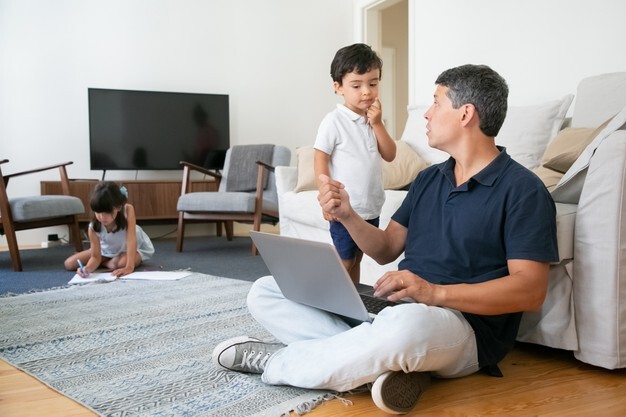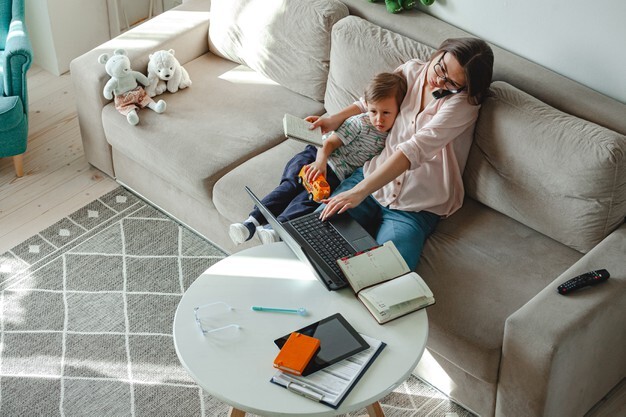What are Speech Sound Disorders?
A gift that most of us take for granted in life is the effortless
Remote therapy, also known as teletherapy, enables a speech and language therapy visit to occur through use of videoconference software like Zoom or Doxy rather than in a physical office or other in-person setting. Teletherapy visits look and feel similar to live therapy visits with one main difference: the therapist and client are not in the same room. The option of teletherapy makes access to the benefits of therapy possible and convenient for people who live miles away from a physical speech language therapy clinic where services are typically provided. Most therapy clinics are located in bigger towns and cities, so remote therapy has most commonly been used to give support to people living in rural areas without access to local in-person services. Teletherapy offers flexibility to both patient and provider because it removes the issue of distance as well as the expense and time of travel to and from the clinic. It also offers everyone equal access to experts and specialists in any needed field. At different stages of the coronavirus pandemic, in-person therapy has been difficult or completely impossible to arrange, depending on current restrictions and closure of in-person service delivery models. As a result, the importance and ubiquity of remote speech therapy has increased dramatically over the past few years.

Remote therapy requires that the therapist and the client both use audiovisual equipment so that they can see and hear each other clearly. The participants of the video call need a stable internet connection and a device for establishing the call – for instance, a laptop, tablet, or smartphone. Many devices come with a built-in camera and microphone that will be sufficient for the purposes of a basic audiovisual call. For higher quality of picture and sound you can also upgrade to an external web camera and/or external microphone. Some people enjoy the use of a headset to pick up sound more clearly and reduce feedback issues. Audiovisual conferencing software like Zoom, Google Meet, or Doxy offer paid subscription options but also offer basic features for free. These free subscriptions are usually time-limited (e.g., only 40-60 minutes per video call before you get booted off). 40-60 minutes is approximately the length of a typical therapy session, so this restriction is not often an issue. Even if this timeframe is not long enough for the purposes of your call, you can immediately start another meeting after the first one times out. For therapists, it is important to investigate the encryption-level of the subscription you are considering. Encryption helps protect your client’s protected health information (PHI) from falling into the wrong hands or being leaked publicly. “End to end encryption” is the industry standard to safeguard your meeting from unwelcome visitors and protect the privacy of your client.
For teletherapy, many speech and language therapists prefer to use digital materials over traditional paper handouts, pictures, and other tangible physical items. Most digital materials will be in Word document or PDF form. These materials can be used in remote therapy because they are easily shared on the screen. In this way, the clients can see and hear everything on the speech and language therapist's screen and participate in activities, look at pictures, or read handouts together. These digital materials can also be emailed to the client who can review them further on the screen or print them out from home if that is their preference. Besides digital content, the therapist can also use physical objects (e.g., dolls, puzzles, books, etc.). They should bring the physical objects close to the camera and be sure that all significant actions are visible on the client’s screen as well as the therapist’s. Sometimes the speech therapist may ask their client’s caregiver to procure specific items, toys, and materials from their own home for use on the screen in a designated way. This method works well for clients who do not yet have a good attention span for two-dimensional representations on the screen. Your therapist will let you know which items (if any) you can prepare before your teletherapy appointment.

Teletherapy with a child requires communication, cooperation, and partnership between the speech therapist and the client’s parents. Before starting, the parents should receive or ask for an overview of what therapy will look like, prepare for the technical details of the videocall, and prepare any needed in-home materials that the speech language therapist requests. Make sure you have agreed upon the appointment time, keeping in mind that time zones may differ when doing remote therapy. Plan ahead to determine where the parent should be during video call. If the client is a child of preschool age, it is advisable that the parent sit with the child in their lap. This way, the parent can guide the child and keep them focused on the tasks presented. With a school-age child, the parent can often just be nearby in case of technical difficulties or needed redirection of the child’s attention. Finding a stable location where the device can rest is a good idea; It is much easier to find a place to rest the device for 40 -60 minutes rather than planning to hold the device in your hand for that long. Consider locating a place where the device can stay plugged in for the duration of the visit, as audiovisual calls can often drain a device’s battery.
According to speech and language therapists who work with children, one of the biggest issues to address in remote therapy is maintaining a child's concentration and motivation for work. Each child requires an individual approach; Some children find it easy to concentrate and feel motivated to engage in sedentary work, while other children find it hard to sit still for long periods of time and become easily distracted. Some parents report that working on a laptop or iPad is intrinsically distracting for their child because of the proximity of YouTube or other favourite apps. Just like in face-to-face therapy, the process of keeping young clients engaged in the tasks at hand requires creativity and planning on the part of the therapist. Many therapists will introduce fun videos, allow for a game, or encourage the child to get up and move for a few minutes in between the exercises to avoid fatigue. The therapist will likely retain control of the visit by screen sharing this fun content from his or her computer and telling the client ahead of time how long each break will last. These fun activities, besides being motivators, can also be used by a savvy therapist to continue to enhance speech and language skills on the sly. Skills like asking questions, taking turns in conversation, or telling a story are intrinsic to many fun activities, games, and videos. Remember, kids learn through play, so chances are that your child’s speech therapist is indirectly targeting speech and language goals even if an activity looks like a lot of fun and giggles!

Kokolingo is a speech and language therapy tool for children with speech sound disorders. It is an ideal example of how modern speech therapy materials are now being created to be equally functional in both remote therapy and in-person therapy settings. Many preschool and school-age children have begun attending their speech therapy sessions remotely since the start of the coronavirus pandemic. As parents and children scrambled to find ways to attend remote school and speech therapy from home, therapists scrambled to locate quality screen-friendly digital speech therapy materials that can be used with a variety of clients.
Here is one example of how a therapist might access Kokolingo during a remote therapy visit using the Chrome web browser. In this example, Google Meet is the audiovisual platform used to share Kokolingo between the two computers.
First, the speech and language therapist and parent must individually acquaint themselves with Google Meet software. To access it, you will need a Google Gmail (email) account, which is completely free and relatively quick and painless to set up. After that, a time for therapy should be agreed upon, keeping in mind that different time zones may come into play. With your free Gmail account comes access to Google Calendar, which will allow the therapist to schedule and share the meeting time into the parent’s calendar. This strategy ensures everyone is on the same page for start and end time and the date of the visit.
When you click on the link that your speech therapist sent you in an email or from the Google calendar, it will open into a private window where you can check your appearance and test your sound before you are visible to anyone else in the meeting. When you are ready, click the button to enter the meeting. Once in the meeting you will have the option to mute/unmute your sound and turn your video on/off as desired. In general, it’s a good idea to keep your audio and video on for the entire visit. Use the volume buttons on your computer to adjust the volume of the other person’s speech. It’s ok to ask your speech language therapist to walk you through some basics of the software so you feel comfortable with the features before diving into the therapy visit.
It is important to stress that the free version of Google Meet allows the duration of the meeting to last up to one hour, but no more, so make sure to pay attention to time. Be mindful and begin to wind down the session as the end time approaches so you won’t be cut off mid-conversation.
More about the functioning of the Google Meet software can be foundhere.
The speech therapist can click a button on the bottom of the Google Meet screen to allow the parent and child to view whatever is visible on the therapist’s computer screen. This is called “screensharing.” More on how to do this can be found here. It is advisable for the therapist to prepare the windows on Chrome with needed materials pulled up and ready in advance. For example, consider logging in to Kokolingo and selecting the activity you will use first before joining the Google Meet call. In another window, you can open an online game or YouTube video to be used as a motivator. This preparation reduces downtime in the visit where a child might become fidgety. Preparation beforehand also keeps the entire visit running smoothly and maintains professional standards.

In order for remote therapy to remain interactive, the speech therapist should still be able to see both child and parent while screen sharing their content. It is ideal to open the Google Meet video in one Chrome window and prepare Kokolingo and all other necessary games and materials in another. For optimal user experience from the therapist’s perspective, many appreciate the ease of having two monitors to make it easier to view all materials and switch between screens. It is also possible to shrink both Chrome windows to fit side by side in one screen. Clients don’t need to worry about multiple windows or screens, but only need to focus on enlarging the Google Meet video for easy viewing. When the therapist starts screensharing, the video the clients see of them will shrink or disappear. You can click and drag on the individual camera feeds to enlarge or shrink them as desired. It’s helpful particularly in speech sound therapy to enhance the visual image of the therapist’s face so the child can better view his or her mouth movements. Parents can also model and exaggerate specific mouth movements needed to produce a specific sound correctly.
In order for the therapy to be successful, the speech therapist and the parent need to communicate and cooperate well with each other. Remote therapy requires a period of adjustment and learning - for the therapist as well as the client and their caregiver. Sharing goals and concerns openly and being honest about how therapy is going will lead to success for the child in speech therapy, regardless of delivery model.
Author: Krešimir Perša, Speech and Language Therapist
Disclaimer: Videoconference materials can be used both for therapeutic and personal purposes. Before you start using a particular software for therapeutic purposes, be sure you are abiding by all laws, codes, and regulations (HIPPA, privacy laws, end-to-end encryption).